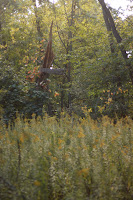Today, I ventured back onto the North Branch Trail to document the newly
changed leaves and their reflections in the Chicago River. Desperate to improve
upon last year's collection of photos of motion blurred water reflecting trees, I spent
more time framing each shot (especially utilizing the rule of thirds), took risks to get a
better angle, and made sure to include a stable subject. Also, the dash of red leaves
helped make the mostly green scenes less monotonous.
With the bottom photo, I walked into the middle of the river. I've seen professional
photographers do it, and if I had brought waterproof pants and a longer tripod it would
seem like the most practical way to get a good picture. Instead I just had boots and
a mini-tripod, so I got wet but it was a good experience. Also, the North Branch of the
Chicago River is much cleaner and shallower than any other part of the river.
Glenview
Taken in September 2012




























